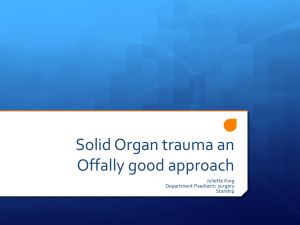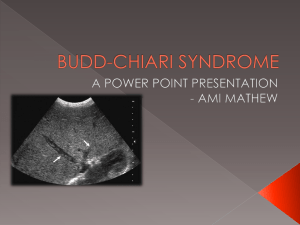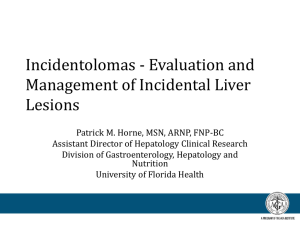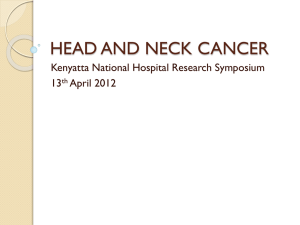Surgery for the Hepatic Cripple
advertisement
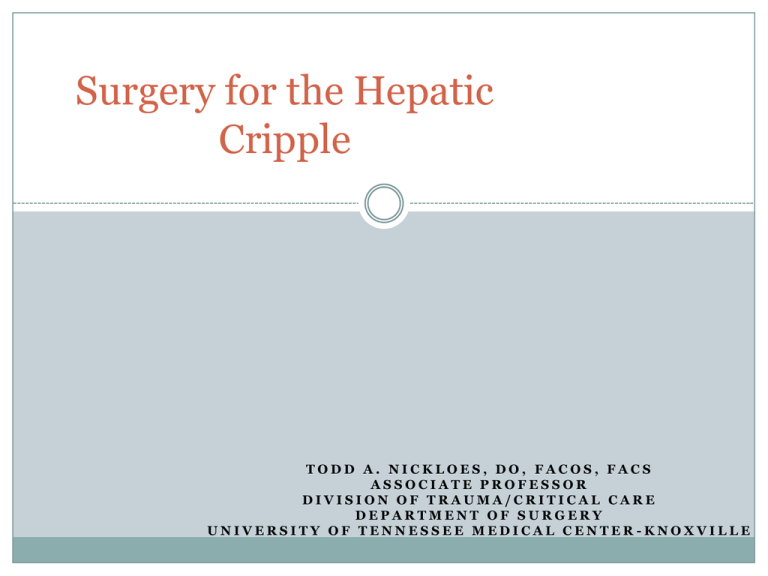
Surgery for the Hepatic Cripple TODD A. NICKLOES, DO, FACOS, FACS ASSOCIATE PROFESSOR DIVISION OF TRAUMA/CRITICAL CARE DEPARTMENT OF SURGERY UNIVERSITY OF TENNESSEE MEDICAL CENTER-KNOXVILLE For my father…. Surgery for the Hepatic Cripple First things first: Anatomy Couinaud classification The Couinaud classification of liver anatomy divides the liver into eight functionally independent segments. Each segment has its own vascular inflow, outflow and biliary drainage. In the center of each segment is a branch of the portal vein, hepatic artery and bile duct (except segment I). In the periphery of each segment there is vascular outflow through the hepatic veins. Because of this division into self-contained units, each segment can be resected without damaging those remaining. For the liver to remain viable, resections must proceed along the vessels that define the peripheries of these segments, (hence, the lines of resection parallel the hepatic veins). The centrally located portal veins, bile ducts, and hepatic arteries are preserved (except in segment I). Surgery for the Hepatic Cripple Surgery for the Hepatic Cripple First things first: Couinaud classification The Couinaud classification of liver anatomy divides the liver into eight functionally independent segments. Each segment has its own vascular inflow, outflow and biliary drainage. In the center of each segment is a branch of the portal vein, hepatic artery and bile duct (except segment I). In the periphery of each segment there is vascular outflow through the hepatic veins. Because of this division into self-contained units, each segment can be resected without damaging those remaining. For the liver to remain viable, resections must proceed along the vessels that define the peripheries of these segments, (hence, the lines of resection parallel the hepatic veins). The centrally located portal veins, bile ducts, and hepatic arteries are preserved (except in segment I). Segments numbering There are eight liver segments. Segment 4 is sometimes divided into segment 4a and 4b according to Bismuth. The numbering of the segments is in a clockwise manner (figure). Segment 1 (caudate lobe) is located posteriorly. It is not visible on a frontal view. Surgery for the Hepatic Cripple Surgery for the Hepatic Cripple Right hepatic vein divides the right lobe into anterior and posterior segments. Middle hepatic vein divides the liver into right and left lobes (or right and left hemi-liver). This plane runs from the inferior vena cava to the gallbladder fossa. Also provides venous drainage for segment 4B. Left hepatic vein divides the left lobe into a medial and lateral part (and drains 4A). Portal vein divides the liver into upper and lower segments. The left and right portal veins branch superiorly and inferiorly to project into the center of each segment On a normal frontal view the segments 1, 6 and 7 are not visible because they are located more posteriorly. The right border of the liver is formed by segment 5 and 8. Although segment 4 is part of the left hemiliver, it is situated more to the right Surgery for the Hepatic Cripple Right hepatic vein divides the right lobe into anterior and posterior segments. (8/5 and 7/6) Middle hepatic vein divides the liver into right and left lobes (or right and left hemiliver). This plane runs from the inferior vena cava to the gallbladder fossa, Cantlie’s Line. Left hepatic vein divides the left lobe into a medial & lateral part. (4a/4b and 2/3) Surgery for the Hepatic Cripple Surgery for the Hepatic Cripple The uppper left figure is a transverse image through the superior liver segments, that are divided by the hepatic veins. LEFT: at the level of the right portal vein. RIGHT: at the level of the splenic vein. Surgery for the Hepatic Cripple So who are we talking about? Surgery for the Hepatic Cripple Portal Hypertension Chronic increase in portal venous pressure (PVP) Due to a mechanical obstruction of portal venous system Normal 5-10 mm Hg Varices begin to develop when PVP 10-12 mm Hg Therapeutic goal of treatment is hepatic venous pressure gradient (HVPG) <12 mm Hg Etiologies Pre-sinusoidal Sinusoidal Postsinusoidal Surgery for the Hepatic Cripple Pre-sinusoidal Sinusoidal Schistosomiasis congenital atresia (hepatic fibrosis) portal vein thrombosis (50% of pediatric cases) Cirrhosis NASH/NAFLD Hepatic fibrosis secondary to hemochromotosis Wilson disease Congenital fibrosis Postsinusoidal Budd-Chiari syndrome (hepatic vein thrombosis) Congenital IVC malformation (web, diaphragmatic hiatus) IVC thrombosis constrictive pericarditis CHF Surgery for the Hepatic Cripple Most common cause of liver failure (& PH) in the US Intrahepatic/Sinusoidal Alcohol induced cirrhosis Closely followed by viral hepatitis induced cirrhosis (50% of cases worldwide) NASH/NAFLD Non-alcoholic steatohepatitis/non-alcoholic fatty liver disease Increasing in US as obesity increases • Obesity • NIDDM • Hyperlipidemia Cryptogenic cirrhosis and HCC • 4.5% increase in relative risk for obese patients Surgery for the Hepatic Cripple “Hey Doc, can you fix this?” Surgery for the Hepatic Cripple “Hey Doc, can you fix this?” Should you? Surgery for the Hepatic Cripple Contraindications to elective surgery in patients with liver disease Acute hepatitis alcoholic or viral Mortality of 10-13% if icteric Child’s class C Fulminant hepatic failure Severe chronic hepatitis Severe coagulopathy PT > 3 minutes on vitamin K Platelet count < 50,ooo Extrahepatic complications Acute renal failure Cardiomyopathy/CHF hypoxemia Surgery for the Hepatic Cripple “but Doc, I need this done so I can take care of my dog! Why won’t you help me?” Surgery for the Hepatic Cripple Parameter Points Assigned Points Assigned Points Assigned 1 2 3 Ascites Absent Slight Moderate Bilirubin < 2 mg/dl 2-3 mg/dl 3 mg/dl Albumin > 3.5 g/dl 2.8-3.5 g/dl < 2.8 g/dl PT < 4 seconds 4-6 seconds 6 seconds INR < 1.7 1.7-2.3 2.3 Encephalopathy None Grade 1-2 Grade 3-4 Class A: 5-6 points (well compensated) 0-15% mortality Class B: 7-9 points (significant functional compromise) 15-45% mortality Class C: 10-15 points (decompensated disease) +/- 70% mortality Child CG, Turcotte JG. Surgery and portal hypertension. Major Probl Clin Surg 1964;1:1-85. [PubMed] Surgery for the Hepatic Cripple MELD score Model for End-stage Liver Disease Originally developed to determine prognosis following a transjugular intra-hepatic shunt (TIPS) procedure for liver failure Widely used in the liver transplant arena to prioritize donor liver allocation Recently validated as having direct correlation between MELD score and 30 day postoperative mortality in non-transplant procedures Surgery for the Hepatic Cripple MELD score Simple rule of thumb 1% increase in mortality per MELD point if MELD score < 20 2% increase per MELD point if > 20 Easy to use at the bedside/clinic given PDA’s today MELD = 3.8[Ln serum bilirubin (mg/dL)] + 11.2[Ln INR] + 9.6[Ln serum creatinine (mg/dL)] + 6.4 where Ln is the natural logarithm (if hemodialysis twice in past week, value for Creatinine is automatically set to 4.0) Note: If any score is <1, the MELD assumes the score is equal to 1. Surgery for the Hepatic Cripple So, now everyone in the room knows the risk…. If you must do surgery, can we mitigate the risk? Surgery for the Hepatic Cripple So, now everyone in the room knows the risk…. If you must do surgery, can we mitigate the risk? Not really….. Surgery for the Hepatic Cripple Let’s break it down Elevated INR In measuring PT/INR, a reasonable goal is to attempt correction with vitamin K and fresh frozen plasma to achieve a prothrombin time within three seconds of normal/INR < 1.5 prior to surgery. Replacing the platelets Recombinant factor VIIA (100 mcg/kg) temporarily corrects the prothrombin time limited by • • • • high cost transient effect an absence of data showing improved outcomes in cirrhotics the associated risk of thromboembolism Tranexamic acid (TXA) 1 gram over 10 minutes followed by 1 gram over 8 hours limited by • high cost • an absence of data showing improved outcomes in cirrhotics Surgery for the Hepatic Cripple However, Evidence has accumulated that the prothrombin time does not correlate with the risk of bleeding in patients with cirrhosis. Decreased levels of all liver synthesized pro-coagulant factors, including the vitamin K dependent clotting factors (II, VII, IX, and X) in patients with cirrhosis are widely recognized. Other liver-synthesized clotting factors that may contribute to hypocoagulability include fibrinogen, factors V, XI, XII, prekallikrein, kininogen, and plasminogen More likely related to a combination of this and HVPG Surgery for the Hepatic Cripple Let’s break it down Elevated bilirubin Further evidence of hepatic failure Metabolism of heme products Make them water soluble for excretion Surgery for the Hepatic Cripple Let’s break it down Elevated Cr Evidence of fluid shift to extravascular space secondary to diminished hepatic protein synthesis Ascites Secondary to hepatic/splanchnic lymph accumulation Hyperaldosteronism with Na retention -> water retention Diuretics with Na restriction (1,000 mg daily) • Spironolactone 25mg BID (max 400mg/d) • counters the Aldosterone • May lead to hepatorenal syndrome (appears like prerenal azotemia) Surgery for the Hepatic Cripple Let’s break it down Elevated Cr Ascites Paracentesis with albumin replacement @ 1 gm/100 cc • Hepatorenal syndrome is a threat • Asterixis (neurologic changes) as ammonia level increases These measures may provide transient improvements – with a small window of opportunity Conundrum: Patient presents with portal hypertension and active UGI variceal hemorrhage not amenable to endoscopic/IR interventions. Surgery for the Hepatic Cripple Think, man, think! What can I do if I absolutely must, but I have some time….? Not a lot….. Surgery for the Hepatic Cripple Think, man, think! What can I do if I absolutely must, but I have some time….? Not a lot….. But… Surgery for the Hepatic Cripple TIPS Procedure Transjugular Intrahepatic Portosystemic Shunt Surgery for the Hepatic Cripple TIPS Procedure 25% of patients who undergo TIPS will experience transient post-operative hepatic encephalopathy… Surgery for the Hepatic Cripple TIPS Procedure 25% of patients who undergo TIPS will experience transient post-operative hepatic encephalopathy,… but it will stop the variceal hemorrhage. Surgery for the Hepatic Cripple TIPS Procedure 25% of patients who undergo TIPS will experience transient post-operative hepatic encephalopathy,… but it will stop the variceal hemorrhage. And preserves the anatomy for potential transplantation reciept Surgery for the Hepatic Cripple Surgery for the Hepatic Cripple Distal Splenorenal shunt -aka Warren shunt -lower rate of encephalopathy -utilized in variceal bleeding -Child’s A patients -contraindicated in refractory ascites as may worsen ascites -not an option in B/C Surgery for the Hepatic Cripple Portocaval shunt End-to-side (Eck) fistula or side-to-side anastamosis May worsen ascites Will worsen encephalopathy Mesocaval shunt Graft between the IVC and Portal vein Worsens encephalopathy Side-to-side will lead to less ascites/hepatic failure than end-to-side Surgery for the Hepatic Cripple Peritoneovenous shunt LeVeen Denver Peritoneum to subclavian vein Modification of LeVeen with subcutaneous hand pump Rarely used secondary to DIC complications Contraindicated in variceal hemorrhage, SBP, hepatorenal syndrome and existent coagulopathy Surgery for the Hepatic Cripple Best advice Child’s A with variceal hemorrhage (MELD < 20) Endoscopy Endoscopy again IR Splenorenal shunt (Warren) TIPS as fallback position Child’s B/C (MELD >20) See above but skip the Warren shunt and go straight to TIPS Transplant service Surgery for the Hepatic Cripple Bibliography Portal venous and segmental anatomy of the right hemiliver: observations based on three-dimensional spiral CT renderings MS van Leeuwen, J Noordzij, MA Fernandez, A Hennipman, MA Feldberg and EH Dillon, Department of Radiology, University Hospital Utrecht, The Netherlands Planning of liver surgery using three dimensional imaging techniques. van Leeuwen MS, Noordzij J, Hennipman A, Feldberg MA. Department of Radiology and Surgery, University Hospital Utrecht, The Netherlands. Clinical and anatomical basis for the classification of the structural parts of liver Saulius Rutkauskas et al. Clinic of Radiology, Institute of Anatomy, Clinic of Surgery, Kaunas University of Medicine, Lithuania Friedman LS. The risk of surgery in patients with liver disease. Hepatology 1999; 29:1617. Greenfield’s Surgery Scientific Principles and Practices, 5th Ed, Lippincott Williams & Wilkins, Philadephia, 2011:916. Surgery for the Hepatic Cripple Bibliography Child CG, Turcotte JG. Surgery and portal hypertension. Major Probl Clin Surg 1964;1:1-85. [PubMed] Malinchoc M, Kamath PS, Gordon FD, et al. A model to predict poor survival in patients undergoing transjugular intrahepatic portosystemic shunts. Hepatology 2000;31:864-71. [PubMed] Northup PG, Wanamaker RC, Lee VD, Adams RB, Berg CL. Model for EndStage Liver Disease (MELD) predicts nontransplant surgical mortality in patients with cirrhosis. Ann Surg. 2005 Aug;242(2):244-51. Wada H, Usui M, Sakuragawa N. Hemostatic abnormalities and liver diseases. Semin Thromb Hemost 2008; 34:772. Contact me Todd A. Nickloes, DO, FACOS, FACS tnickloe@mc.utmck.edu

